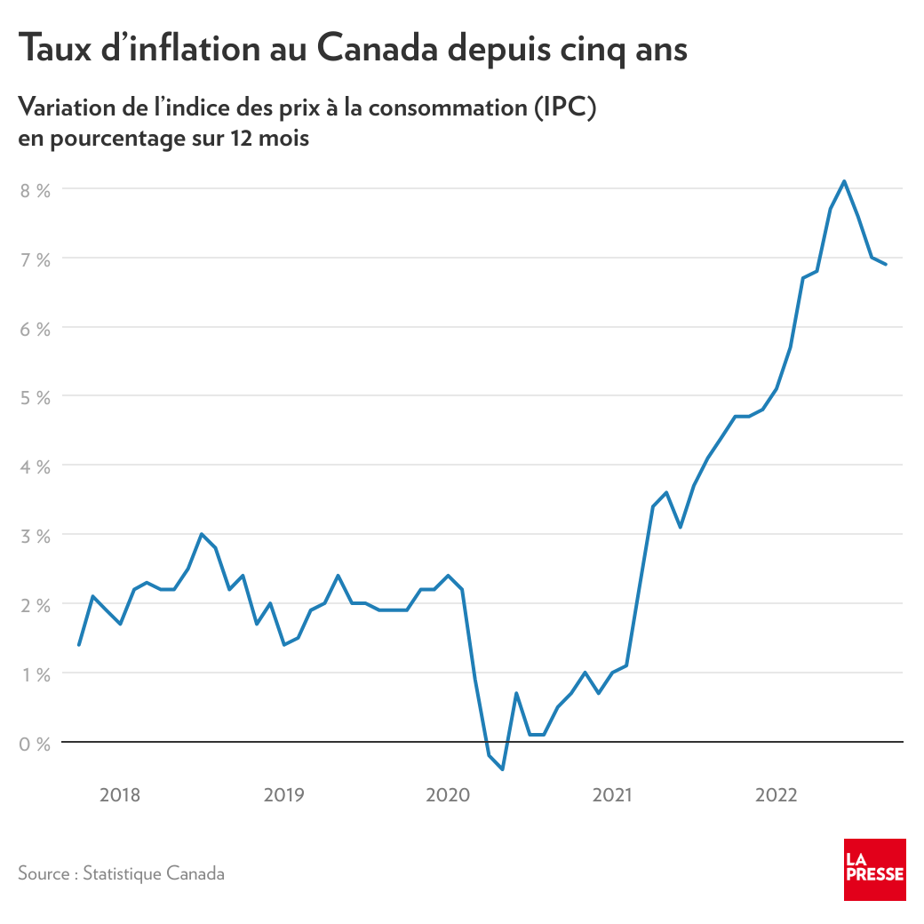The Bank of Canada still has work to do to quell inflation, which is showing signs of easing, but which is still hitting very hard where it hurts the most, at the grocery store.
Posted at 8:37
Updated at 5:19 p.m.
The consumer price index (CPI), which tracks the cost of a fixed basket of popular goods and services, rose 0.1% between August and September, but the annual rate of increase decreased slightly from 7.0% to 6.9%. In Quebec, annual CPI growth went from 7.1% in August to 6.5% in September.
Despite a drop in gas prices, the significant increase in the price of food purchased in grocery stores is keeping inflation at a level more than three times higher than the 2% target set by the Bank of Canada.

Gasoline prices fell 7.4% in September, but are still up 13.2% over the past year.
Food costs 10.5% more than a year ago, driven by price increases for baked goods (+14.8%), fresh vegetables (+11.8%), dairy products ( +9.7%) and meat (+7.6%).
It’s the 10e months in a row that the price of food purchased from stores is higher than the CPI, which measures overall inflation.
According to Statistics Canada, food is costing more because of a combination of factors, including unfavorable weather conditions and the increase in the price of inputs such as fertilizer and natural gas caused by the war in Ukraine.
Excluding energy and food, the inflation rate stood at 5.4% in September. Mortgage costs, which are directly affected by the fight against inflation, added 0.1% to headline inflation.
Encouraging signs
The Bank of Canada tracks inflation measures other than the headline CPI, namely the CPI-trim and the CPI-med, which remained unchanged in September.
These two measures, however, continue to decline on an annualized basis of three months, which is an encouraging sign, notes the head of macroeconomic strategy of Desjardins, Royce Mendes.
“CPI-tronq now stands at 3.7% and CPI-med at 3.5%, which at least gives hope that the underlying trend in price growth is slowing down”, analyzes he.
After reaching 8.1% in June, the annual inflation rate fell to 7% in August before settling at 6.9% in September.
National Bank economists also believe that the trend is encouraging. “The positive developments on the inflation front and the significant moderation in the pace of the economy suggest that price pressures will be less strong in the months to come,” believe economists Matthieu Arseneau and Alexandra Ducharme.
The Canadian economy recorded weak growth of 0.1% during the months of June and July. Since the start of 2022, the economy has been growing at a modest annual rate of 0.7%, according to Statistics Canada.
The Bank of Canada is specifically seeking to slow down the economy with its interest rate hikes, to calm inflation.

BLAIR GABLE PHOTO, REUTERS ARCHIVES
Tiff Macklem, Governor of the Bank of Canada
Central Bank Governor Tiff Macklem will provide an update on his fight against inflation on Wednesday, October 26.
Even with recession looming, Macklem last week reiterated his intention to keep raising interest rates.
A further increase in the key rate, the sixth since March, is therefore expected next week. Desjardins expects an increase of at least 75 points, which would bring the rate to 4%.

